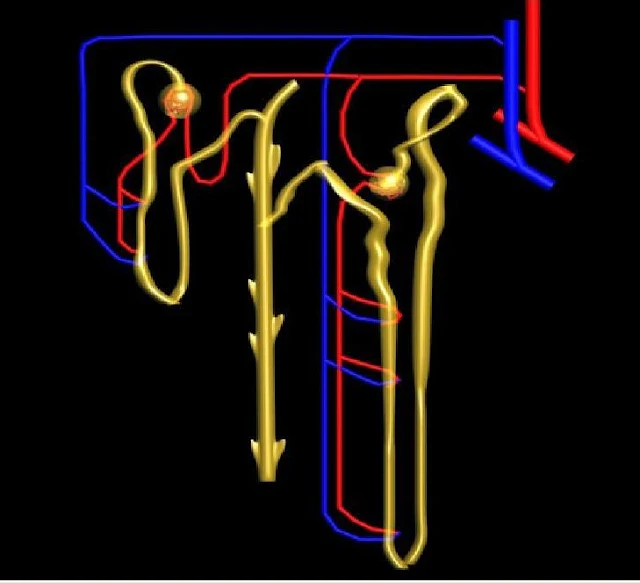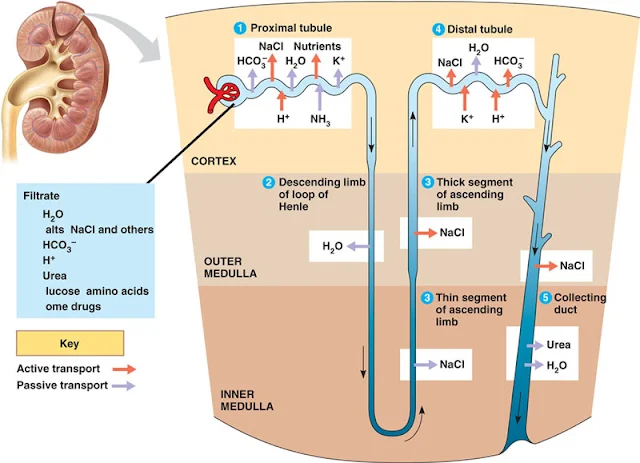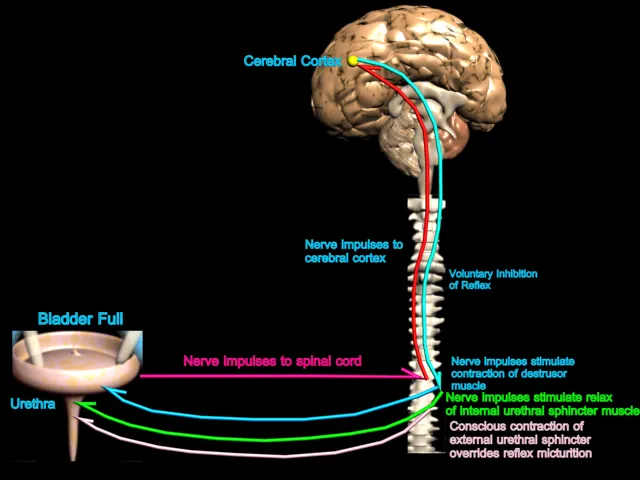 |
| Anatomical Position of Urinary System in Human Body |
URINARY SYSTEM:
 |
| Different Organs of Urinary System in Human Body |
This system is the main excretory system and consists of the following structures:
2 Kidney, which secrete urine.
2 Ureters, which convey the urine from the kidneys to the urinary bladder.
The urinary bladder where urine collects and is temporarily stored.
The urethra through which urine is discharged from the urinary bladder to the exterior.
This system plays a vital part in maintaining homeostasis of water and electrolyte concentrations within the the body.The kidney produce urine that contains metabolic waste products, including the nitrogenous compounds urea and uric acid, excess ions and some drugs.
 |
| Urinary System with Human Penis and Prostate Glands |
The main functions of kidney:
1) Formation and secretion of urine.
2) Production and secretion of Erythropoietin,the hormone that controls formation of red blood cells.
3) Production and secretion of renin ,an important enzyme in the control of blood pressure.
4) Urine is stored in the bladder and excreted by the process of Micturition.
 |
| Different Parts of Urinary System With Labels |
KIDNEYS:
The kidneys lie on the posterior abdominal wall,one on each side of the vertebral column,behind the peritoneum and below the diaphragm.They extend from the level of 12th thoracic vertebra to the 3rd lumbar vertebra,receiving some protection from the lower rib cage.The right kidney is usually slightly lower than the left,probably because of the considerable space occupied by the liver. Kidneys are bean shaped organs, about 11 cm long 6 cm wide.3cm thick and weight 150gm.
 |
| Internal Anatomy of Kidney |
Gross structure of the kidney:
There are 3 areas of tissue that can be distinguished when a longitudinal section of the kidney is viewed with the naked eye.
A fibrous capsule,surrounding the kidney The cortex, a reddish-brown layer of tissue immediately below the capsule and outside the pyramids.
The medulla,The innermost layer consisting of pale conical-shaped striations, the renal pyramids.
The hilum is the concave medial border of the kidney where the renal blood and lymph vessels,the ureter and nerves enter.The renal pelvis is the funnel-shaped structure that acts as a receptacle for the urine formed by the kidney.It has a number of distal branches called calyces , each of which surrounds the apex of a renal pyramid.Urine formed in the kidney passes through a papilla at the apex at the pyramid into minor calyx,then into a major calyx before passing through the pelvis into the ureter.The walls of the pelvis contain smooth muscle and are lined with transitional epithelium.
Peristalsis of the smooth muscle originating in pacemaker cells in the walls of the calyces propels urine through the pelvis and ureters to the bladder.This is an intrinsic property of the smooth muscles,and is not under nerve control.
Microscopic Structure of Kidney:
The kidney composed of about 1 million functional units, the Nephrons, and a smaller number of collecting ducts. The collecting ducts transport urine through the pyramids to the renal pelvis, giving them their striped appearance. The tubules are supported by small amount of connective tissue, containing blood vessels, nerves and lymph vessels.
 |
| Microscopic Structure of Nephron |
The Nephron:
 |
| Microscopic Structure of Nephron with Labels |
The nephrons consists of a tubule closed at one end, the other end opening into a collecting tubule. The closed or blind end is indented to form the cup-shaped glomerular capsule (Bowman`s Capsule), which almost completely encloses a network of arterial capillaries, the glomerulus. Continuing from the glomerular capsule the remainder of the nephron is about 3 cm long and is described in 3 parts:
1) The proximal Convoluted tubule
2) The medullary Loop (Loop of Henley)
3) The distal convoluted tubule,
Leading into the collecting duct. The collecting ducts unite, forming larger ducts that empty into the minor calyces. After entering the kidney at the hilum the renal artery divides into smaller arteries and arterioles. In the cortex an arterioles, the afferent arteriole, enters each glomerular capsule and then subdivides into a cluster of capillaries, form in the glomerulus. Between the capillary loops are connective tissue phagocytic mesangial cells, which are part of the monocyte-macrophages system. The blood vessel leading away from the glomerulus is the efferent arteriole. It breaks up into a second capillary bed eventually leaves the kidney in the renal vein, which empties into the inferior vena cava.
The blood pressure in the glomerulus is higher than in other capillaries because the diameter of the afferent arteriole is greater than that of the efferent arteriole.
The walls of the glomerulus and the glomerular capsule consists of a single layer of flattened epithelial cells. The glomerular walls are more permeable than those of other capillaries. The remainder of the nephron and the collecting tubule are formed by a single layer of highly specialised cells.
 |
| Microscopic Slide Picture of Mammalian Kidney Taken By Me (Manash Kundu) |
The blood vessels of the kidney are supplied by both sympathetic and parasympathetic nerves. The presence of both branches of the autonomic nervous system control renal blood vessel diameter and renal blood flow independently of auto regulation.
URETERS:
The ureters are the tubes that convey urine from the kidneys to the urinary bladder.They are about 25 to 30 cm long with a diameter of about 3 mm. the ureter is continuous with the funnel-shaped renal pelvis. It passes downwards through the abdominal cavity,behind the peritoneum in front of the psoas muscle into the pelvic cavity and passes obliquely through the posterior wall of the bladder.
Structure:
The ureters consist of 3 layers of tissue:
An outer covering of fibrous tissue,continuous with the fibrous capsule of the kidney.
A middle muscular layer consisting of interlacing smooth muscle fibres that form a functional unit spiralling round the ureter,some in clockwise and some in anticlockwise directions and an additional outer longitudinal layer in the lower third.
An inner layer, the mucosa,composed of transitional epithelium.
Function:
The ureters propel urine from the kidneys into the bladder by peristaltic contraction of the smooth muscle layer.
 |
| Anatomical Position of Urinary System in Human Body |
URETHRA:
The male urethra provides a common pathway for the flow of urine and semen, the combined secretions of the male reproductive organs.It is about 19 to 20 cm long and consists of three parts.The prostatic urethra originates at the urethral orifices of the bladder and passes through the prostate gland.The membranous urethra is the shortest and narrowest part and extends from the prostate gland to the bulb of the penis, after passing through the perineal membrane.The spongiose or penile urethra lies within the corpus spongiosum of the penis and terminates at the external urethral orifices in the glans penis.
 |
| Different Parts of Urinary System With Labels |
URINARY BLADDER:
This is a reservoir for urine.It lies in the pelvic cavity and its size and position vary, depending on the volume of urine it contains.When distended,the bladder rises into the abdominal cavity.
Structure:
The outer layer of loose connective tissue,containing blood and lymphatic vessels and nerves,covered on the upper surface by the peritoneum.
The middle layer,consisting of a mass of interlacing smooth muscle fibres and elastic tissue loosely arranged In 3 layers.This is called the detrusor muscle and when it contracts,It empties the bladder.
The mucosa,composed of transitional equilibrium.The 3 orifices in the bladder wall form a triangle or trigone.The upper two orifices on the posterior wall are the openings of the ureter.
 |
| FORMATION OF URINE through Kidney`s Functional unit Nephron |
FORMATION OF URINE:
The kidneys form urine, which passes through the ureters to the bladder for storage prior to excretion.The composition of urine reflects exchange of substances between the nephron and the blood in the renal capillaries.Waste product of protein metabolism are excreted,electrolyte levels are controlled and pH(Acid base balance) is maintained by excretion of hydrogen ions. There are 3 processes involved in the formation of urine:
1) Filtration
2) Selective absorption
3) Secretion
 |
| Different Stages during Formation of Urine through Kidney`s Functional unit Nephron |
Filtration:
This takes place through the semipermeable walls of the glomerulus and glomerular capsule.Water and other small molecules pass through,Although some are reabsorbed later.Blood cells,Plasma protein, and other large molecules are too large to filter through and therefore remain in the capillaries.The filtrate in the glomarulus is very similar in composition to plasma with the important exception of plasma proteins.
Filtration is assisted by the difference between the blood pressure in the glomerulus and the pressure of the filtrate in the glomerular capsule.Because the efferent arteriole is narrower than the afferent arteriole, a capillary hydrostatic pressure of about 7.3 kPa(55mmHg) builds up in the glomerulus.This pressure is opposed by the osmotic pressure of the blood,provided mainly by plasma-proteins,about 4kPa(30 mmHg) and by filtrate hydrostatic pressure of about 2kPa (15 mmHg) in the glomerular capsule.The net filtration pressure is therefore;
7.3-(4+2) = 1.3kPa, or
55-(30+15) = 10 mmHg.
The volume of filtrate formed by both kidneys each minute is called the glomerular filtration rate(GFR).In a healthy adult the GFR is about 125 ml/min;i.e. 180 litres of filtrate are formed each day by the two kidneys.Nearly all of the filtrate is later reabsorbed with less than 1%, i.e. i to 1.5 litres,excreted as urine.The diffrences in volume and concentration are due to selective reabsorption of some filtrate constituents and tubular secretion of others.
Selective Reabsorption:
Selective reabsorption is one process by which the composition and volume of the glomerular filtrate are altered during its passage through the convoluted tubule.This process enables reabsorption,into the blood,of those filtrate constituents needed to maintain fluid and electrolyte balance and the pH of the blood.Active transport takes place at carrier sites in the epithelial membrane,using chemical energy to transport substances against their concentration gradients.
Some constituents of glomerular filtrate(Glucose,Amino acids) do not normally appear in urine because they are completely reabsorbed unless blood levels are excessive.The kidney`s maximum capacity for reabsorption of a substance is the transport maximum, or renal threshold.For example, the normal blood glucose level is 3.5 to 8 mmol/1(63 to 144 mg/100 ml) and if this rises above the transport maximum of about 9mmol/1(160 mg/100 ml), glucose appears in the urine.This occurs because all the carrier sites are occupied and the mechanism for active transport out of the tubules is overloaded.Other substances reabsorbed include Sodium, Calcium,Potassium,Phosphate and chloride.
Parathyroid Hormone: from the parathyroid glands and calcitonin from the thyroid gland together regulate reabsorption of calcium and phosphate.
 |
| Antidiuretic Hormone (ADH): Role in reabsorption. |
Antidiuretic Hormone: (ADH) from the posterior lobe of the pituitary gland increases the permeability of the distal convoluted tubules and collecting ducts increasing water reabsorption.
 |
| Aldosterone: Role in reabsorption |
Aldosterone: Secerted by adrenal cortex, increases the reabsorption of sodium and excretion of potassium.
 |
| Atrial Natriuretic peptide (ANP): Role in reabsorption |
Atrial Natriuretic peptide: (ANP) secreted by the atria of the heart in response to stretching of the atrial wall,decreases reabsorption of sodium and water in the proximal convoluted tubules and collecting ducts.It also inhibits secretion of ADH and aldosterone.
Tubular Secretion:
It is occurs as the blood flows through the glomerulus.Substances not required and foreign materials,e.g. drugs including penicillin and aspirin,may not be cleared from the blood by filtration because of the short time it remains in the glomerulus.Such substances are cleared by secretion into the convoluted tubules and excreted from the body in the urine.Tubular secretion of hydrogen ions(H+) is important in maintaining normal blood pH.
MICTURITION:
 |
| Micturition process |
The urinary bladder acts as a reservoir for urine.When 300 to 400 ml of urine have accumulated, afferent autonomic nerve fibers in the bladder wall sensitive to stretch are stimulated.In the infant this initiates a spinal reflex and micturition occurs . Micturition occurs when autonomic efferent fibers convey impulses to the bladder,causing contraction of the detrusor muscle and relaxation of the internal urethral sphincter. When the nervous system is fully developed.The micturition reflex is stimulated but sensory impulses also pass upwards to the brain and there is awareness of the need to pass urine.By learned and conscious effort contraction of the external urethral sphincter and muscles of the pelvic floor will inhibit micturition for a limited period.
 |
| Detrusor muscle of Urinary Bladder |
In adults, micturition occurs when the detrusor muscle contracts, and there is reflex relaxation of the external sphincter. It Can be assisted by increasing the pressure within the pelvic cavity,achieved by lowering the diaphragm and contracting the abdominal muscles.Over distension of the bladder is extremely painful, and when this stage is reached there is a tendency for involuntary relaxation of the external sphincter to occur allowing a small amount of urine to escape,provided there is no mechanical obstruction.
All 3D Picture of Urinary System Created by Me (Manash Kundu)
























 Online Movies
Online Movies
No comments:
Post a Comment